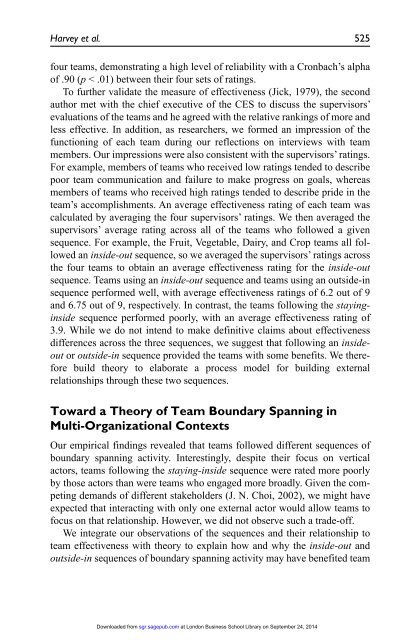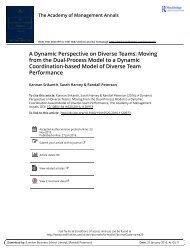The Process of Team Boundary Spanning in Multi-Organizational Contexts - Sarah Harvey, Randall S. Peterson, and N. Anand
Work teams must increasingly operate in complex environments characterized by multiple external actors beyond team and organizational boundaries. Although previous research demonstrates the importance of boundary spanning activities to team effectiveness, it reveals relatively little about the process of boundary spanning in these environments. In this article, we investigated the processes of boundary spanning across multiple external actors in 10 cross-organizational teams. We identified three sequences for reaching out to external actors: (a) moving inside-out from vertical actors inside the host organization to horizontal actors outside of the host organization, (b) moving outside-in from horizontal actors to vertical, and (c) staying-inside with vertical actors from the host organization. Our observations suggest that inside-out and outside-in sequences were more successful than simply pleasing the host organization. We build on our empirical findings to develop a process theory of how team boundary spanning activities across multiple external actors influence team effectiveness. Our research underscores the importance of a team’s interactions with actors in its external environment beyond those in an immediate supervisory role and provides insight into the dynamics of boundary spanning in multi-organizational contexts.
Work teams must increasingly operate in complex environments
characterized by multiple external actors beyond team and organizational
boundaries. Although previous research demonstrates the importance of
boundary spanning activities to team effectiveness, it reveals relatively little
about the process of boundary spanning in these environments. In this article,
we investigated the processes of boundary spanning across multiple external
actors in 10 cross-organizational teams. We identified three sequences for
reaching out to external actors: (a) moving inside-out from vertical actors inside
the host organization to horizontal actors outside of the host organization,
(b) moving outside-in from horizontal actors to vertical, and (c) staying-inside
with vertical actors from the host organization. Our observations suggest
that inside-out and outside-in sequences were more successful than simply
pleasing the host organization. We build on our empirical findings to develop
a process theory of how team boundary spanning activities across multiple
external actors influence team effectiveness. Our research underscores the
importance of a team’s interactions with actors in its external environment beyond those in an immediate supervisory role and provides insight into the
dynamics of boundary spanning in multi-organizational contexts.
You also want an ePaper? Increase the reach of your titles
YUMPU automatically turns print PDFs into web optimized ePapers that Google loves.
<strong>Harvey</strong> et al. 525<br />
four teams, demonstrat<strong>in</strong>g a high level <strong>of</strong> reliability with a Cronbach’s alpha<br />
<strong>of</strong> .90 (p < .01) between their four sets <strong>of</strong> rat<strong>in</strong>gs.<br />
To further validate the measure <strong>of</strong> effectiveness (Jick, 1979), the second<br />
author met with the chief executive <strong>of</strong> the CES to discuss the supervisors’<br />
evaluations <strong>of</strong> the teams <strong>and</strong> he agreed with the relative rank<strong>in</strong>gs <strong>of</strong> more <strong>and</strong><br />
less effective. In addition, as researchers, we formed an impression <strong>of</strong> the<br />
function<strong>in</strong>g <strong>of</strong> each team dur<strong>in</strong>g our reflections on <strong>in</strong>terviews with team<br />
members. Our impressions were also consistent with the supervisors’ rat<strong>in</strong>gs.<br />
For example, members <strong>of</strong> teams who received low rat<strong>in</strong>gs tended to describe<br />
poor team communication <strong>and</strong> failure to make progress on goals, whereas<br />
members <strong>of</strong> teams who received high rat<strong>in</strong>gs tended to describe pride <strong>in</strong> the<br />
team’s accomplishments. An average effectiveness rat<strong>in</strong>g <strong>of</strong> each team was<br />
calculated by averag<strong>in</strong>g the four supervisors’ rat<strong>in</strong>gs. We then averaged the<br />
supervisors’ average rat<strong>in</strong>g across all <strong>of</strong> the teams who followed a given<br />
sequence. For example, the Fruit, Vegetable, Dairy, <strong>and</strong> Crop teams all followed<br />
an <strong>in</strong>side-out sequence, so we averaged the supervisors’ rat<strong>in</strong>gs across<br />
the four teams to obta<strong>in</strong> an average effectiveness rat<strong>in</strong>g for the <strong>in</strong>side-out<br />
sequence. <strong>Team</strong>s us<strong>in</strong>g an <strong>in</strong>side-out sequence <strong>and</strong> teams us<strong>in</strong>g an outside-<strong>in</strong><br />
sequence performed well, with average effectiveness rat<strong>in</strong>gs <strong>of</strong> 6.2 out <strong>of</strong> 9<br />
<strong>and</strong> 6.75 out <strong>of</strong> 9, respectively. In contrast, the teams follow<strong>in</strong>g the stay<strong>in</strong>g<strong>in</strong>side<br />
sequence performed poorly, with an average effectiveness rat<strong>in</strong>g <strong>of</strong><br />
3.9. While we do not <strong>in</strong>tend to make def<strong>in</strong>itive claims about effectiveness<br />
differences across the three sequences, we suggest that follow<strong>in</strong>g an <strong>in</strong>sideout<br />
or outside-<strong>in</strong> sequence provided the teams with some benefits. We therefore<br />
build theory to elaborate a process model for build<strong>in</strong>g external<br />
relationships through these two sequences.<br />
Toward a <strong>The</strong>ory <strong>of</strong> <strong>Team</strong> <strong>Boundary</strong> <strong>Spann<strong>in</strong>g</strong> <strong>in</strong><br />
<strong>Multi</strong>-<strong>Organizational</strong> <strong>Contexts</strong><br />
Our empirical f<strong>in</strong>d<strong>in</strong>gs revealed that teams followed different sequences <strong>of</strong><br />
boundary spann<strong>in</strong>g activity. Interest<strong>in</strong>gly, despite their focus on vertical<br />
actors, teams follow<strong>in</strong>g the stay<strong>in</strong>g-<strong>in</strong>side sequence were rated more poorly<br />
by those actors than were teams who engaged more broadly. Given the compet<strong>in</strong>g<br />
dem<strong>and</strong>s <strong>of</strong> different stakeholders (J. N. Choi, 2002), we might have<br />
expected that <strong>in</strong>teract<strong>in</strong>g with only one external actor would allow teams to<br />
focus on that relationship. However, we did not observe such a trade-<strong>of</strong>f.<br />
We <strong>in</strong>tegrate our observations <strong>of</strong> the sequences <strong>and</strong> their relationship to<br />
team effectiveness with theory to expla<strong>in</strong> how <strong>and</strong> why the <strong>in</strong>side-out <strong>and</strong><br />
outside-<strong>in</strong> sequences <strong>of</strong> boundary spann<strong>in</strong>g activity may have benefited team<br />
Downloaded from sgr.sagepub.com at London Bus<strong>in</strong>ess School Library on September 24, 2014
















